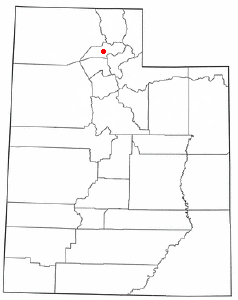The Ogden River, flowing through downtown Ogden, has long been a dump for tires, appliances, cars, and trash. The Ogden River Restoration Project aims to change that, emphasizing the amenity value of the river, and restoring riparian habitat and restoration opportunities.
 The project began as the idea of a private investor who purchased several parcels near the river. Although these were potentially prime riverfront properties, they were mostly abandoned or run-down housing, junkyards, and industrial sites.
The project began as the idea of a private investor who purchased several parcels near the river. Although these were potentially prime riverfront properties, they were mostly abandoned or run-down housing, junkyards, and industrial sites.
The developer, Gadi Lesham, was interested in urban redevelopment, including a hotel, condos and retail shops. He contacted Jason Carey of River Restoration, a river engineering firm in Glenwood Springs, Colorado, for help with the floodplain study required by the city to acquire permits.
Together, Lesham and Carey recognized the greater potential of the project, not just urban re-development, but river restoration as well. They realized that cleaning up the river and restoring natural riparian processes would, in turn, add economic value to the neighboring properties. River Restoration staff began to contact state agencies and seek sources of funding to help cover the costs of the riparian restoration project.
In the meantime, the recession hit. Lesham filed for bankruptcy and had to give up his role in the Ogden River Project. By then, however, the project had a life of its own. When grants from the Utah Division of Water Quality became available, the agency contacted River Restoration and inquired if they would be interested in submitting a proposal for the Ogden River project. After securing state-level funding, River Restoration started developing support from the City of Ogden, local residents, Trout Unlimited, and others. They applied for and received, federal stimulus funding, and the project gained momentum.
On the one-mile stretch that is the site of the initial phase of the project, restoration crews have removed five to seven whole cars, recycled 5,000 tons of concrete and scrap metal, to a landfill facility, 6,000 cubic yards of unusable waste materials, including 4,000 cubic yards of broken glass bottles from an early 1900s brewery operation. Additionally, 4,000 tons of boulders have been installed for fish habitat and for bank stabilization, and 40,000 new plants will be planted, many in stormwater return areas, which will help to remove sediment, contaminants, and trash from stormwater before it flows into the river.
The final stages of the project are still in the planning phase, but the vision is grand. The riparian restoration will cover five river miles on the Ogden and Weber Rivers which meet at the west edge of downtown Ogden. Beyond the river banks, abandoned housing and junkyards will be replaced with urban redevelopment, including residential and commercial uses. As part of the redevelopment plan, the city requires 75-foot setbacks from the river to protect riparian function and reduce risk of property damage from flooding.
A key component of the project has also been one of the greatest obstacles: the establishment of a property boundary for the river. In essence, this has required that property owners along the river either sell or donate easements to the city all along the stretch of the river that is being restored. While some people have been happy to cooperate, Lesham, for example, donated easements on his properties, others have held out, generally requesting greater compensation than the city can afford. To date, this problem has not been entirely resolved, and will likely continue to be an issue as the project progresses. The easements are important because they redefine the city’s flood mapping to be coincidental with the 100-year floodplain, which ensures that development does not occur within this zone.
The city has succeeded in acquiring 17 acres of riverfront property for parkland. They have set aside funds for the long-term maintenance of this area, and the process has begun to develop a monitoring plan for the river, in coordination with state agencies, universities, and local groups.
Note from Community: Upon request, we can provide suggested contract procedures and guidelines.
Ogden River Restoration Project Factsheet – PDF
Ogden-River-Restoration_Project-factsheetOgden River Proposal for Stimulus Funds – PDF
Storm Water and River Restoration Easement | Ogden, UT – PDF
River Restoration – website
Ogden River Parkway Trail – website
Downloaded from ResilientWest.org
a project of
Resilient Communities and Watersheds
- Challenges:
- fiscalhealth
- regionalcollab
- urbanform
- publichealth
- waterquality
- Land Use:
- openspace, mixeduse, commercial
- State:
- utah
- Scale:
- regional, community
- Type:
- urban, suburban, amenity, rural

